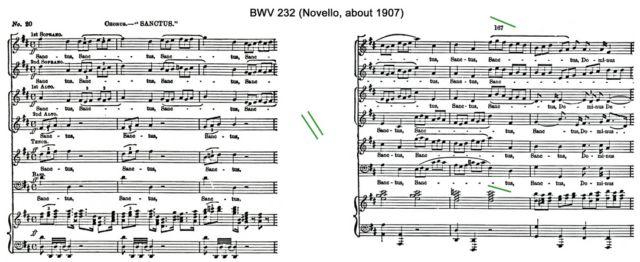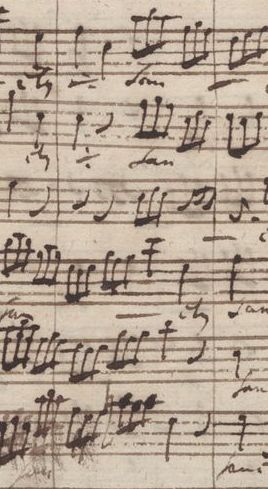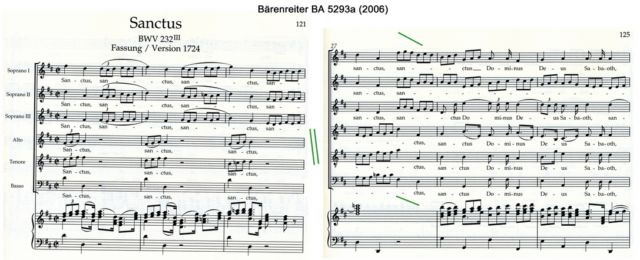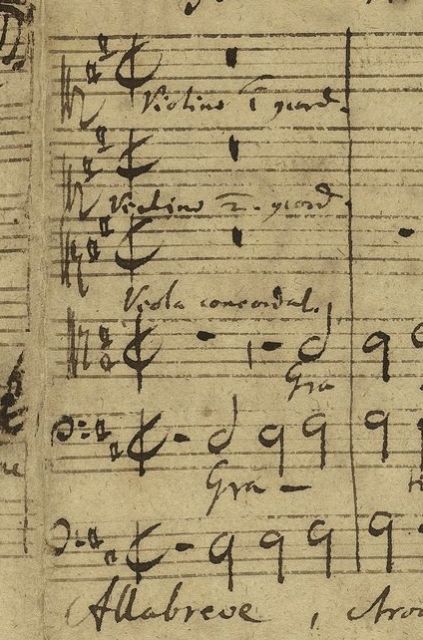|
|
Bach's Mass in B minor: consecutive double octaves in the Sanctus Angelic octaves | Back in the 1970s, when rehearsing the B minor Mass BWV 232 with the Sheffield Bach Choir, the late Roger Bullivant would have us repeat a few bars in the middle of the Sanctus. Finding a fault in the score, Roger would say in his inimitable way: 'mmm, he'd surely gave corrected that if he'd seen it; it's evidence that the work was never performed'. At the time, it wasn't generally known that the work was given by Bach, on several occasions.
As shown below, the 'that' above is a technical issue in bar 27 between the first sopranos and the basses. There are consecutive double octaves, veiled it's true by the angelic triplets (only the first note of each triplet counts contrapuntally), and perhaps by other devices. This is one of the forbidden contrapuntal progressions listed without explanation in textbooks such as 'First Year Harmony'. Bach was careful about correct counterpoint; he composed at his desk, and picked up errors during rehearsal. Although a few obscure "consecutives" can be found in the '48' and elsewhere, the present one comes high enough on the scale of contrapuntal contravention to be worth noticing. On the other hand it's also a little bit obscure; there are 6 choral voices and there would (presumably) be no technical problem if the first and second sopranos were to swap their notes for the third or fourth beat.
This doesn't look like a slip of the quill, however, particularly in the light of present-day knowledge. Here's a copy of an old edition; bar 27 is the middle bar on the right: |  |
| | It's now known that the Sanctus was written as a separate work, BWV 232(III), for Christmas 1724 at Leipzig. It was given on subsequent occasions and seems to have formed the nucleus of the complete Mass. The consecutive double octaves are already there in this early version, as shown below in the autograph and in a urtext of the vocal score (Bärenreiter BA 5293a, Early versions of the Mass in B minor). In the preface to this edition it says specifically that Bach checked and annotated the parts. Crucially, the score had to be re-written for the B Minor Mass, in order to transpose the third soprano to first alto. If Bach's quill slipped, seraphic angels must have made it slip, on at least two occasions. Here's a close-up of bar 27 of the scan of the 1724 autograph, which can be downloaded from http://www.bach-digital.de/receive/BachDigitalSource_source_00000825. The bass part is in the bass clef, and (as usual at the time) the soprano parts are in the soprano clef (middle C is the bottom line of the stave). |  |
| | The published edition is more readable for modern musicians: |  |
|  Why did he do it? | It looks like a deliberate mistake, so what's the hidden message? Pat Saunders replied to a version of this note in the defunct forum of that erudite Facebook page 'Every time you write parallel fifths Bach kills a kitten', to say that Bach saw the octave as a representation of Heaven and Earth. The Sanctus is all about Heaven and Earth getting joined up, and angels are the messengers. Furthermore, the error happens to be between the choral first angels and the double-grumpies. True, not every day of Bach's life had been a happy one. Also, in his new job transient problems with the choir school resulted in unsatisfactory Key Performance Indicators. According to modern experts, this led Bach to restrict his aspirations for the rest of his life to giving dispiriting historically informed performances.
Bach's thoughts were surely of something more universal. That something could have been one of the wonkier mysteries of creation, known to the ancient Greeks: musical scales that allow pure harmony don't add up to an octave. Double the length of a vibrating string or organ pipe and you get the octave below. Take 2/3rds of the length and you go up a perfect fifth. Start on some note and go up 12 fifths and down 7 octaves in a convenient order: you visit (sort of) the 12 notes of a keyboard octave and would expect to end up on the note you started from. But, you end up nearly a quarter of a semitone low. Even worse, hardly any of the harmonic intervals in your circle of fifths are perfectly consonant. This problem won't be fixed properly before (if that's the word) the next Big Bang arrives. That's why people were subjected to plainchant (or equivalent) for two millenia.
Only two years before the Sanctus, Bach had completed the first book of 24 preludes and fugues, written to illustrate how a suitable kludge can alleviate the effects of nature's imperfection. Experts on temperaments are troubled because he didn't say what his favourite kludge was. |
|  How did he show it was deliberate? | Given that Bach might have been sending some kind of message, how could he have, as it were, signed it? He was keen on numerology, an ancient means of mystifying the masses that may leave some people cold nowadays. In Bach's time, it was also a common practice to have one's personal number; his was B-a-c-h = 2 + 1 + 3 + 8 = 14 and he used it a lot. Having said that, here are so many ways of extracting a 14 from his names that it seems you could, if you really want to, find a conspiracy theory in almost any of his compositions. Ruth Tatlow wrote a book about the subject, in order to challenge some published nonsense.
Many writers have noted that Bach carefully wove into the score of the Sanctus the sacred numbers of the biblical source: Isaiah chapter 6, verses 2 and 3:
[(1) In the year that king Uzziah died I saw also the LORD sitting upon a throne, high and lifted up, and his train filled the temple.]
(2) Above it stood the seraphims: each one had six wings; with twain he covered his face, and with twain he covered his feet, and with twain he did fly.
(3) And one cried unto another, and said, Holy, holy, holy, is the LORD of hosts: the whole earth is full of his glory.
Of the six choral voices, three were sopranos in the early version, to go with the three trumpets and three oboes. That matches the three spheres, each of three orders, in the hierarchy of angels. The seraphims were top management. Your guardian angel, which you may have wanted to strangle when you were seven-and-a-half, is at the bottom of the pile. Apparantly, if you think this is all a load of rubbish you won't necessarily go to hell for all eternity.
How can we find a '14' in bar 27 the Sanctus? The easy way is to multiply 2 by 7, which Bach would probably have liked if he really had been thinking that way.
A remark by Barney Sherman (www.bsherman.net/bachtempo.htm) sets off another train of thought. Barney was discussing the modern fad for what could be called 'HIPster' ('Bullivantine' in Sheffield) warp speeds for performances, a subject that doesn't concern us here. Time signatures are thought to indicate baroque composers' intentions with respect to speed. Barney noted that, whereas the B minor Mass has 'C' as time signature (common 4/4 time), the original 1724 version has the alla breve indication(common time 'C' with a vertical line). This can mean either 4/2 or 2/2 (compare for example the B major and E major fugues of Book II of the 48). We note that the early versions of the second Kyrie and the Gratias Agimus Tibi, BWV 232(I), are alla breve but barred in 4/2 time. Short vertical lines are added half way through some of these long bars to guide the reader, as shown below for the early version of the Gratias. |  |
| | Incidentally, given that Bach found it necessary to guide performers through these long bars, with their big long notes in the antique style, it's hard to understand why the Gratias and particularly the Dona Nobis Pacem are given so indecently fast nowadays. |
| | The 1724 Sanctus has full bar lines throughout (see illustration given earlier). It has the same note values and bar lines as in the B minor Mass (see illustrations above), so the alla breve clearly indicates 2/2. This conveniently avoids the off-topic number '4', but otherwise it may attract attention because it doesn't really suit the crotchet (quarter-note) beats. So, why did Bach indicate alla breve for the early version of the Sanctus, and change his time signature for the B minor Mass in a way that doesn't change the appearance of the score? Could it be that if you switch from 2/2 time to 4/2 (removing half the bar lines) and count up on your fingers, the angelic consecutive double octaves arrive in the first half of bar 14? We could, then, speculate that Bach used the alla breve ambiguity to cover his tracks. |
|  Conclusion | It's all idle speculation and it's hard to know if this little story is worth telling. After all, the early Sanctus brought only a couple of minutes of brilliance to what seems to have been an interminable ceremony. On the other hand it was the starting point for one of the most profound works ever written.
| | Download pdf version (3.3 MB) |
|
|
| Copyright © 2013. Tous droits réservés. | 13 April 2013 | Contact: crl@chrblee.net |
|
|
|

